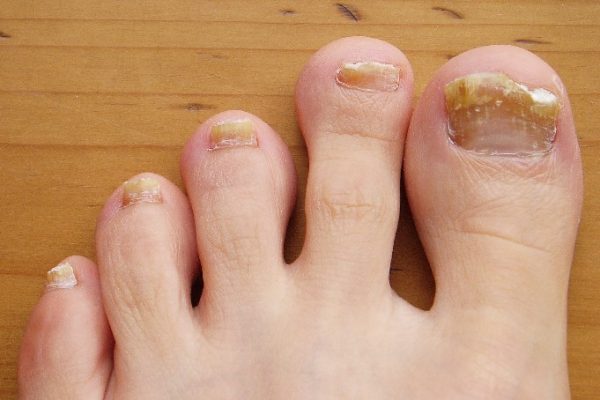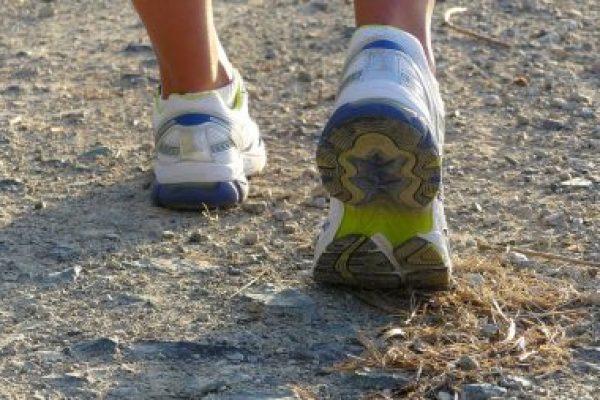Common Foot and leg CONDITIONS
We treat a large range of foot and leg conditions.
At Cheltenham Podiatry we Treat a Range of Conditions:
We treat a wide range of common foot conditions such as fungal nails and arthritis, ingrown toenails, shin splints and more. We believe that conditions should not hold you back, and we work collaboratively to come up with a treatment plan and strategies to allow you to enjoy life to the fullest.
Read more about the range of conditions we are experts in the conditions below:
This frustrating condition occurs when fungal microorganisms inhabit the nails. These organisms prefer a dark, warm and moist environment, and toenails provide this.
Fungal infections in the nail often begin at the tip of the nail, gradually moving underneath the nail. Over time, this interferes with nail health and appearance.
Nails can appear white, yellow, discoloured, thickened in some cases and brittle. We offer Toe FX to combat fungal nails. Talk to your podiatrist about the treatment today.
Plantar fasciitis is an inflammation, irritation or degeneration of the plantar fascia, a band of tissue that connects the heel bone to the ball of the foot.
A common symptom of plantar fasciitis is pain when standing up first thing in the morning, as well as after rest. Throughout the day, the heel pain will usually return. Causes are usually a combination of poor biomechanical foot function, incorrect footwear, standing long hours on hard surfaces or acute injury. Click here for more information. Click here for basic rehab.
In some cases where pain is severe, tears can occur in the fascia over time, and this can prevent standard therapies from resolving the condition. Plantar Fascia tears requires an alternative treatment plan, involving bracing, injection therapy, rehabilitation and often orthotics in the long term.
Other causes of heel pain are Baxters nerve, or medial calcaneal nerve irritation, fat pad atrophy, and bursitis are the more common ones.
Talk to your podiatrist about solutions for you.
Achilles tendinitis, now more accurately known as Achilles tendinopathy or tendinosis, is a condition that causes pain and inflammation at the back of the heel.
There are two main types of tendinopathy: at the heel bone (insertional) or just above the heel bone in the mid-portion (non-insertional).
Treatments for this condition includes a rehabilitation program, along with heel pads and sometimes orthotics, and Perineural prolotherapy and in some case high volume ultrasound guided hydro dissection.
Diabetes is a chronic disease whereby a person’s body does not produce sufficient insulin.
Diabetes can also directly affect the feet in various ways if blood glucose levels aren’t properly maintained.
Being equipped with an effective diabetic foot management plan and appropriate footwear as advised by a podiatrist can minimise diabetic foot complications and improve mobility. Click here for more information.
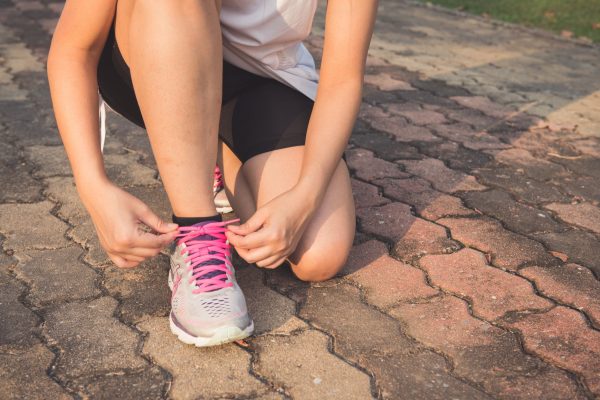
ARTHRITIS/JOINT PAIN
‘Arthritis’ is actually an umbrella term for many different conditions that affect the joints, which also means there can be many different causes and symptoms.
Stiffness, redness, and joint pain are common symptoms of arthritis. Osteoarthritis is the most common arthritic variation.
In the foot, joints commonly affected include the big toe joint, ankle joint and midfoot joints.
There are several different treatment options depending on the individual case, category and severity of arthritis.
These include footwear and /or orthotics, to offload the joint, often accompanied by rehabilitation, laser and ultrasound guided injections. Joint injections are best assisted with ultrasound to ensure precise placement. Injectants include prolotherapy and prp. These are both anabolic types of injectant ( meaning they encourage healing and build up tissue), unlike catabolic , that tends to break down tissue and proteins.
Your podiatrist can recommend and implement the best solution for your conditionI

INGROWN TOENAILS
Ingrown nails are nails that have punctured the skin as they grow forward. They are painful, usually down the side of the nail, and will often appear red and inflamed. They may also weep fluid. Ingrown nails should not be left untreated, as they may become chronically infected, and will often not heal until the nail spike is removed.
Cheltenham podiatrists offer various options to treat the condition. From simple reshaping of the nail edge to remove the sharp spike, to nail bracing system, or in chronic cases, a very simple nail correction procedure (surgery) can be performed under local anesthetic to prevent the problem from recurring in the future. Click here for more information.
Book an appointment at Cheltenham Podiatry to discuss ingrown toenail solutions that suit you.

HEEL PAIN CHILDREN/SEVERS DISEASE
Sever’s Disease is a growth-related condition seen most commonly in children aged 5 – 11 years old, and a common cause of heel pain. The pain often increases with activity and some children will even experience pain undergoing regular activities, such as walking. Sever’s Disease is usually relieved by rest. The condition is due to the pulling of the Achilles and calf muscle at its attachment to the growth plate of the calcaneus (heel bone) as the legs grow and elongate, resulting in inflammation and pain.
Treatment of Sever’s Disease often includes heel raises, exercises, orthotics and photobiomodulation (low-level laser) . However, it is a self-limiting condition, as the growth plate eventually ossifies.
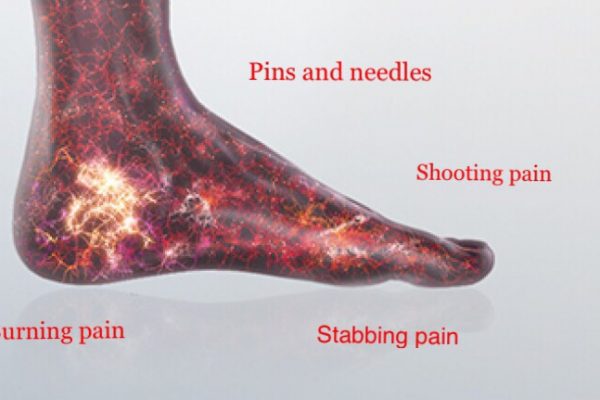
NERVE PAIN
Nerve pain is a common condition treated at Cheltenham Podiatry, our podiatrists are experts in treating these concerns. Nerve Pain is often described as extreme sensations (often sharp shooting, or burning pain) and is often due to a compression injury or trauma/ damage to a nerve. Usually occurring after surgery, traumatic or repetitive injury or/and tight footwear. In the past, treatment options have been limited to strong pain medication that can often have unwanted side effects.
Mortons neuroma is a common nerve condition in the forefoot. It often occurs between the 3rd and 4th Metatarsal heads at the common plantar digital nerve where it travels through the transverse ligament. It can be due to narrow toe box shoes, poor biomechanics, and pressure between the ball of the foot and tranverse ligament.
Nerve pain at the top of the foot is commonly result of pressure from poor or ill fitting footwear, or other traumatic events leading to inflammation of the branches of the superficial fibular nerve.
Tarsal tunnel syndrome is a condition where a branch of the Posterior Tibial nerve is compressed as it travels through the anatomical region of the tarsal tunnel on the inside of the ankle. Pain sensations can radiate into the sole, heel, arch and toes. Any tissue that compresses the nerve can lead to the condition, eg swollen tendons, varicosities, cysts, ganglions or ankle injuries.
Here at Cheltenham podiatry, we are passionate in providing latest techniques that are safer and side-effect-free. This includes photobiomodulation ( infra red and red laser light), and various injection therapies, including perineural injection therapy(also known as lyftogt PIT), and nerve hydrodissection.
Photobiomodulation is a pain free treatment, that can reduce inflammation and pain and help heal damaged nerves. This can also help reduce pain from peripheral neuropathies, as seen in diabetic neuropathy.
Perineural Injection therapy-(Lyftogt PIT) is a dynamic and innovative regenerative treatment, a form of prolotherapy involving a medical grade 5% dextrose solution subcutaneously. It’s safe, simple , usually only requiring between 3-6 sessions.
In some cases, nerve hydrodissection, a more recently developed technique- where an ultrasound guided injection usually of 5% dextrose releases the nerve form scar tissue, and compressive forces can be also performed where appropriate.
Hydrodissection can also be used with other injectants in high volume to free the irritated nerves from surrounding tissue. Click here for more information.

knee arthritis
Knee arthritis and degeneration is a common condition. Can be aggravated as we age, or by traumatic events causing damage to to the supportive structures, leading to instability and damage.
Often ligaments and or the menisci can also be damaged.
Research shows appropriate rehabilitation is crucial to reduce pain and improve outcomes. In situations where this provides limited results, regenerative injection therapy can ice added to improve outcomes and slow further degeneration. Ultrasound sound guided injections ensure precise placement of the injectant.variopus options of injections are available, including prolotherapy and prp.

SHIN SPLINTS
‘Shin Splints’ is a general term used for shin pain. The most common cause is a pulling of the soft tissue away from the boney sheath. It is characterized by pain along the inner border of the shin, and can occur at the beginning or end of exercise, as well as during.
Causative factors include biomechanical abnormalities, downhill/uphill running, activity on uneven surfaces, a sudden increase in training, activity on hard surfaces and inappropriate footwear.
Podiatry is an important part of the management of this condition, particularly to correct foot function and loading, alongside orthotic therapy. Treatment may also include stretching exercises, footwear changes, night splints and training advice.

ULCER CLINIC
At our ulcer clinic, the podiatrists have years of experience dealing with foot ulcers. Ulcers are often caused by a combination of systemic and local issues, including diabetes, poor vascular supply, trauma, foot deformity, and infection.
Once our podiatrists understand the cause, we can use a number of effective solutions. Treatment in our ulcer clinic will often include offloading of the wound with paddings, orthotics, shoes and expert dressing, depending on the type of wound. In cases of infected wounds, antibiotics and/or PACT photodynamic antimicrobial therapy may also be required.
For diabetic and reduced blood flow ulcers not responding to standard care, several other options are available, including photobiomodulation and platelet rich fibrin.. The latter is a new application that can be used to accelerate wound healing, in which a platelet rich clot is applied to the wound, releasing high concentrations of growth factors over 5 days. It is reapplied weekly, and shows promising results.

BUNIONS (HALLUX VALGUS)
Bunions are a common problem that can develop in the main joint of the big toe.
Largely a genetic condition, it may not be particularly painful initially, but once fully developed can cause major foot deformities including clawed toes, hallux valgus, overlapping toes and corns and calluses.
If picked up early, podiatry treatment (exercises, prolotherapy, splints and orthotics) and advice on footwear can reduce pain, slow down the condition and help prevent some of the complications.
Once the deformity develops, osteoarthritis will form, resulting in further pain. This can be relieved with regenerative therapy.
Book an appointment
Get Advice and treatment for your condition
Suffering from foot or leg conditions? Talk to an experienced podiatrist at Cheltenham Podiatry.
We have the tools, expertise and friendly attitude to help you.
Book an appointment using our online form, or call our team today on 03 9583 3093.
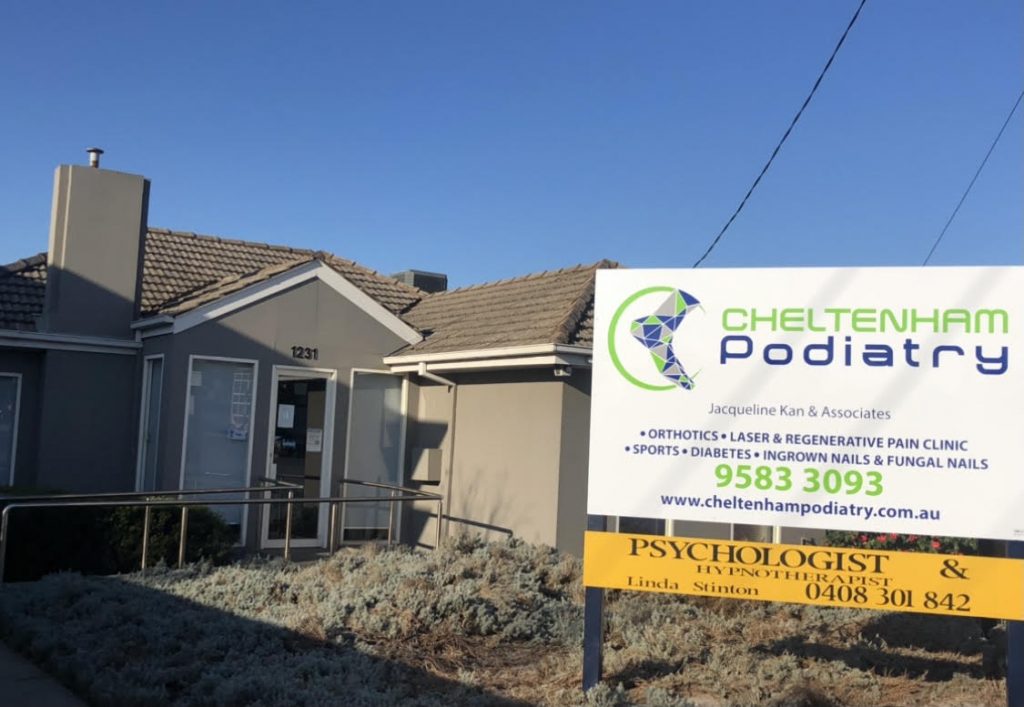


© Copyright 2025, Cheltenham Podiatry | SBM

